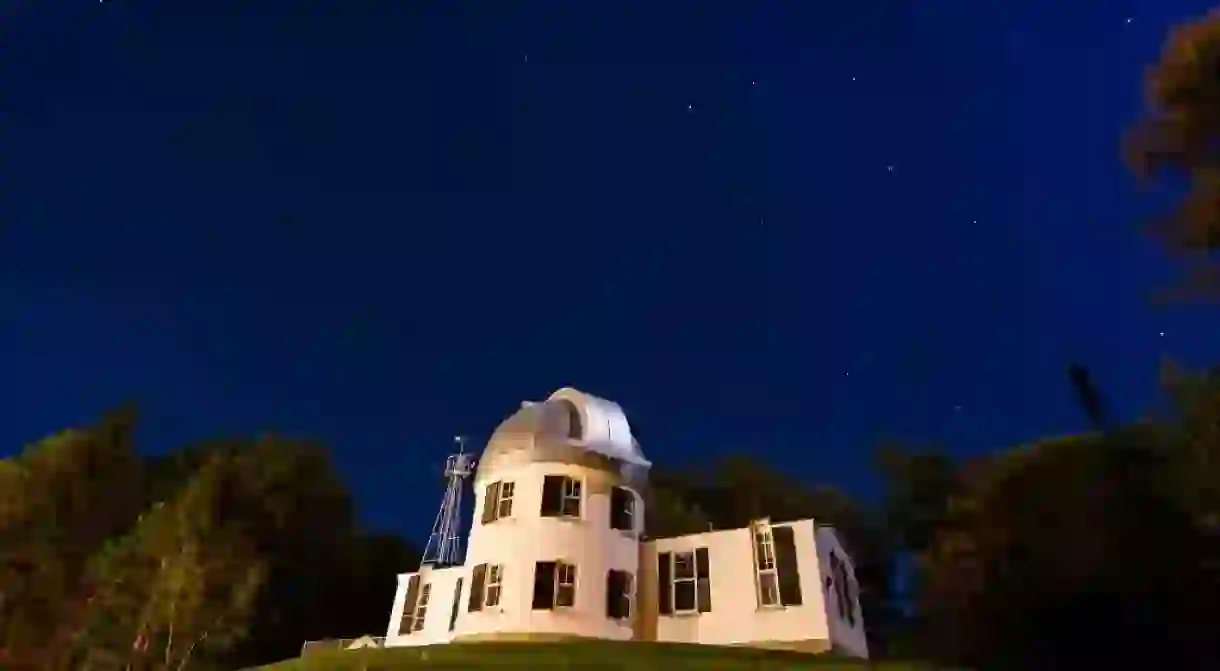The Best Places to Stargaze in New England

Bucolic by day, New England’s rural stretches are stargazing playgrounds. Sure, there’s more humidity than the southwest, but for those who can’t get to the desert, the northeast is dotted with dark sites with no light pollution. Since many of the best sites are at or near parks and protected wilderness, star gazing in New England can be paired with other activities, like hiking and camping. These best sites for stargazing will convert you into a night owl.
Acadia National Park
The view is just as spectacular when the lights go down in Acadia National Park. One of Maine’s eastern-most points is arguably the best place to watch the heavens pass. The sea breeze keeps the skies clear and the national park cuts down on any light pollution. Popular spots include the summit of Cadillac Mountain, the site of the annual Star Party (not just telescopes, but talks and walks too).
Cadillac Mountain, Mount Desert Island, ME

Jordan Planetarium and Emera Astronomy Center
Set in the dark of northern Maine, this planetarium holds the Clark Telescope, an 8-inch lens built in 1900. Set in the University of Maine in Orono, the observatory is small but viewing the stars through an old telescope has a romance that can’t be replicated by gazing at stars through a monitor. Fans of modern telescopes need not worry: a second, 20-inch reflecting scope provides research-grade views through a computer. There are free public shows on Fridays and Sundays.
Emera Astronomy Center 167 Rangeley Road, Orono, ME, +1 207 581 1341
Astronomical Society of Northern New England
Springfield Telescope Makers
Shrine
Northeast Kingdom Astronomy Foundation
A newcomer to star gazing, this observatory set in rural northern Vermont is ideally suited for observation. Set behind an elementary school (they partner with local area schools), the foundation runs the Northern Skies Observatory, featuring a 17-inch scope that adjusts its direction with the earth’s rotation.
Northeast Kingdom Astronomy Foundation, 336 Bayley-Hazen Road, Peacham VT

Arunah Hill Natural Science Center
The Appalachian Trail
The Appalachian Trail is perfect for celestial gazing. In New Hampshire, the Appalachian Mountain Club has trained guides who can not only walk you through the woods but also a field of stars, constellations and galaxies. Visitors at their lodges and huts can gaze through their telescopes at various points along the trail. Lectures are also held, on topics ranging from sun spots and solar flares to planet viewing and eclipses.
Mount Washington
Sure, the weather is inhospitable to human life, but look at those views. Mount Washington, home to some of the coldest temperatures in the U.S. (its official motto is “Home of the World’s Worst Weather”), is a stunning place to contemplate the heavens. Located in New Hampshire’s White Mountains, in the summer the mountain offers summer star gazing parties, which promise stunning photos of the Milky Way. You can hike to the summit, but stargazers lugging telescopes can also drive (the road is open May to October, depending on the weather).
https://www.instagram.com/p/BYLqGrln-eP/?taken-at=234356561
Mount Washington, Sargent’s Purchase NH
Dartmouth College

Haystack Mountain State Park
Park













